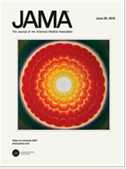JAMA:研究发现老年人中未经治疗的肾衰竭率显著较高
2012-06-20 EurekAlert! EurekAlert!
芝加哥–据6月20日刊《美国医学会杂志》JAMA上的一项研究披露,在一项包括了近2百万加拿大成年人的研究中,年龄较长者的未经治疗的肾衰竭的进展速度大大高于较年轻者的进展速度。 根据文章的背景资料:“据在年龄、肾功能及临床后果之间的相关性研究报告,与较年轻的病人相比,老年病人不太可能发展成终末期肾脏疾病(ESRD),他们更可能死亡而不是进展成肾功能衰竭,甚至是在最低水平的估计肾小球滤过率时 [eG
芝加哥–据6月20日刊《美国医学会杂志》JAMA上的一项研究披露,在一项包括了近2百万加拿大成年人的研究中,年龄较长者的未经治疗的肾衰竭的进展速度大大高于较年轻者的进展速度。
根据文章的背景资料:“据在年龄、肾功能及临床后果之间的相关性研究报告,与较年轻的病人相比,老年病人不太可能发展成终末期肾脏疾病(ESRD),他们更可能死亡而不是进展成肾功能衰竭,甚至是在最低水平的估计肾小球滤过率时 [eGFR;这是滤液通过肾脏的流速] 也是这样。”
加拿大阿尔伯塔省卡尔加里大学的Brenda R. Hemmelgarn, M.D., Ph.D.及其同事开展了一项研究,旨在确定年龄是否与经过治疗的肾衰竭(肾脏替代疗法:接受长期透析或肾移植)的可能性、未经治疗的肾衰竭及全因死亡率间具有相关性。这项研究包括了加拿大阿尔伯塔省的181,6824名成年人,这些人在2002年5月至2008年3月间在门诊检测过他们的eGFR;他们的基线eGFR为15 毫升/分/1.73 平方米或以上而且这些人在本研究开始时无需肾脏替代疗法。本研究的主要检测结果是校正过的经过治疗的肾脏衰竭的速率、未经治疗的肾脏衰竭的速率(在没有肾脏替代疗法时进展成eGFR <15 毫升/分钟/1.73 平方米)及死亡率。
在一个中位期(中点)为4.4年的随访中,有9,7451 (5.4%) 名该研究的参与者死亡,有3295人 (0.18%) 发生了经过治疗后的肾衰竭,有3116人 (0.17%)发生了未经治疗的肾衰竭。研究人员发现,在每一个eGFR的阶层中,校正的死亡率会随着年龄的增长而增加。此外,在每一eGFR的阶层中,经过治疗的肾脏衰竭速率在最年轻的病人组中始终较高。文章的作者写道:“例如, 在最低的eGFR阶层中 (15-29 毫升/分钟/1.73 平方米),在最年轻(18-44岁)的病人中的校正的经过治疗的肾脏衰竭速率要比最年长(85岁或以上)年龄组的病人高出10倍以上。”
在未经治疗的肾脏衰竭中则明显有着相反的结果。未经治疗的肾衰竭的风险随着较低的 vs. 较高的eGFR的部类而增加,而这一相关性随着年龄的增加而变得更强。在最低的eGFR阶层中(15-29毫升/分钟/1.73平方米),经较正的未经治疗的肾衰竭率在最老年龄层(85岁或以上)的病人中要比最年轻年龄层(18-44岁)的病人高出5倍以上。
研究人员写道,他们的结果提示,在老年人中的晚期肾脏疾病的发生率可能因为仅考虑经过治疗的肾脏衰竭率而被大大地低估。
“这些发现对临床实践及决策具有重要的意义;结合考虑许多患有晚期慢性肾脏疾病 [CKD] 的老年人没有得到充分透析准备的发现,这些结果提示有必要在老年人中对CKD的进展进行优先的评估和识别。我们的发现还意味着临床医生应该为那些可能会从透析中得益的老年人提供透析治疗——并应该为那些不太可能从长期透析疗法中得益(或那些选择不接受长期透析疗法)的患者提供一种以保守治疗(包括在时机恰当时的临终关怀)方式进行的积极的替代透析的疗法。鉴于有大量的罹患严重CKD的老年病人,这些结果还突显了更加积极地识别有CKD的老年人,对其症状负担进行评估,以及研发对其合适的治疗策略的需要。最后,我们的研究证明,有必要更好地理解未经治疗的肾脏衰竭的临床意义及在老年人中影响透析启动决定的因素,以及共享对罹患晚期CKD的老年人决策过程的的重要性。”

doi:10.1001/jama.2012.6455
PMC:
PMID:
Rates of Treated and Untreated Kidney Failure in Older vs Younger Adults
Brenda R. Hemmelgarn, MD, PhD; Matthew T. James, MD, PhD; Braden J. Manns, MD, MSc; Ann M. O’Hare, MD, MA; Paul Muntner, PhD; Pietro Ravani, MD, PhD; Robert R. Quinn, MD, PhD; Tanvir Chowdhury Turin, MD, PhD; Zhi Tan, MSc; Marcello Tonelli, MD, SM; for the Alberta Kidney Disease Network
Context Studies of kidney failure in older adults have focused on receipt of dialysis, which may underestimate the burden of disease if older people are less likely to receive treatment. Objective To determine the extent to which age is associated with the likelihood of treatment of kidney failure. Design, Setting, and Participants Community-based cohort study of 1 816 824 adults in Alberta, Canada, who had outpatient estimated glomerular filtration rate (eGFR) measured between May 1, 2002, and March 31, 2008, with a baseline eGFR of 15 mL/min/1.73 m2 or higher and who did not require renal replacement therapy at baseline. Age was categorized as 18 to 44, 45 to 54, 55 to 64, 65 to 74, 75 to 84, and 85 or more years and eGFR as 90 or higher, 60 to 89, 45 to 59, 30 to 44, and 15 to 29 mL/min/1.73 m2. Main Outcome Measures Adjusted rates of treated kidney failure (receipt of dialysis or kidney transplantation), untreated kidney failure (progression to eGFR <15 mL/min/1.73 m2 without renal replacement therapy), and death. Results During a median follow-up of 4.4 years, 97 451 (5.36%) died, 3295 (0.18%) developed kidney failure that was treated and 3116 (0.17%) developed kidney failure that went untreated. Within each eGFR stratum the rate of treated kidney failure was higher in younger compared with older people. For example, in the lowest eGFR stratum (15-29 mL/min/1.73 m2), adjusted rates of treated kidney failure were more than 10-fold higher among the youngest (18-44 years) compared with the oldest (≥85 years) groups (adjusted rate, 24.00 [95% CI, 14.78-38.97] vs 1.53 [95% CI, 0.59-3.99] per 1000 person-years, respectively; P < .001). Rates of untreated kidney failure were consistently higher at older ages. In the eGFR stratum of 15 to 29 mL/min/1.73 m2, adjusted rates of untreated kidney failure were more than 5-fold higher among the oldest (≥85 years), compared with the youngest (18-44 years) groups (adjusted rate, 19.95 [95% CI, 15.79-25.19] vs 3.53 [95% CI, 1.56-8.01] per 1000 person-years, respectively; P < .001). Rates of kidney failure overall (treated and untreated combined) demonstrated less variation across age groups; eg, the adjusted rate per 1000 person years for those with eGFR of 15-29 mL/min/1.73 m2 was 36.45 (95% CI, 24.46-54.32) among participants aged 18 to 44 years and 20.19 (95% CI, 15.27-26.69) among those aged 85 years or older (P = .01). Conclusion In Alberta, Canada, rates of untreated kidney failure are significantly higher in older compared with younger individuals.
本网站所有内容来源注明为“梅斯医学”或“MedSci原创”的文字、图片和音视频资料,版权均属于梅斯医学所有。非经授权,任何媒体、网站或个人不得转载,授权转载时须注明来源为“梅斯医学”。其它来源的文章系转载文章,或“梅斯号”自媒体发布的文章,仅系出于传递更多信息之目的,本站仅负责审核内容合规,其内容不代表本站立场,本站不负责内容的准确性和版权。如果存在侵权、或不希望被转载的媒体或个人可与我们联系,我们将立即进行删除处理。
在此留言













#研究发现#
79
#肾衰竭#
59